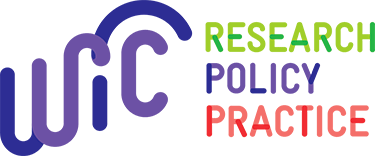The purpose of this study was to determine the extent to which NY Fit WIC, a childhood obesity prevention initiative, was adopted and implemented by the New York State WIC Program. All agencies carried out a variety of activities. The researchers suggested that given a very strong adoption of the program, an outcome evaluation was warranted, to help determine behavior change.
The purpose of this study was to determine the effects of breastfeeding and sugar-sweetened- beverage (SSB) consumption on the prevalence of overweight and obesity in Hispanic toddlers enrolled in the WIC Program. Results indicated that breastfeeding for 1 year or longer and low SSB consumption during the toddler years could significantly reduce prevalence of obesity in Hispanic toddlers.
The goal of this study was to assess the accuracy of maternal perceptions of their children's weight status. Almost all mothers in the study classified their overweight or obese child as being about the right weight. As a result, they might not see obesity interventions as relevant to their families. researchers concluded that parents need education in two areas: (1) how to identify whether their children are overweight or obese and (2) the consequences of obesity.
This studied looked at overweight and obesity trends in a multi-ethnic population of low-income preschool children enrolled in the New York State WIC Program. researchers found that annual obesity prevalence peaked in 2003, declined between 2003 and 2005, and plateaued through 2007, while annual prevalence for overweight increased from 2002 through 2007.
The purpose of this study was to test the feasibility of a pilot study and compare the effectiveness of two approaches to weight management—facilitate group discussions and a self-guided approach, involving newsletters—among postpartum women enrolled in the WIC Program. No significant difference was found between the two groups.
The number of children at risk of being overweight has grown during the past two decades, as has the number of young children whose families participate in the Special Supplemental Nutrition Program for Women, Infants, and Children (WIC). Are these increases connected? According to the author, the answer appears to be no. However, being from a low-income family;especially a low-income, Mexican-American family;did raise the probability of a child's risk of being overweight. This brief examines trends in the relationship between WIC participation and weight status, by updating the results of Food and Nutrition Assistance Programs and Obesity: 1976-2002 (USDA/ERS, Economic Research Report No. 48), to include data from the 2003-2006 National Health and Nutrition Examination Survey (NHANES).
Researchers investigated factors that affect food choices and health beliefs among low-income women. They found that the women were concerned about diabetes, hypertension, and overweight/obesity. In addition, most also believed that their health status had genetic or metabolic origins. They also perceived healthy foods as unaffordable.
The purposes of this study were to assess prevalence of overweight and obesity among urban 1- to 5-year-olds and estimate risk by age and gender. The results showed that significant increases in overweight and obesity occurred between ages 1 and 3. And, more than half of the urban children were overweight or obese by age 5. Furthermore, boys were more likely to be obese than were girls. Based on their findings, the researchers recommended that obesity prevention interventions should be targeted to children between the ages of 1 and 3.
Researchers conducted a systematic review of literature on obesity prevention and other healthy eating and physical activity interventions targeted at children ages 0 to 5 years old. While there was variety in study design, most interventions were multifaceted and showed at least some level of effectiveness for obesity prevention behavior in this population.
The authors analyzed multiple years of cross-sectional data to understand trends in the relationship between food assistance program participation and body weight. High rates of overweight and obesity among low-income populations in the US had raised questions about whether federal food and nutrition assistance programs contributed to the problem. To examine this possibility, the study investigated (1) the extent to which overweight and obesity had increased over time for food and nutrition assistance recipients (focusing on the Food Stamp Program and WIC) and (2) the degree to which increases might simply have mirrored national trends in overweight and obesity.
